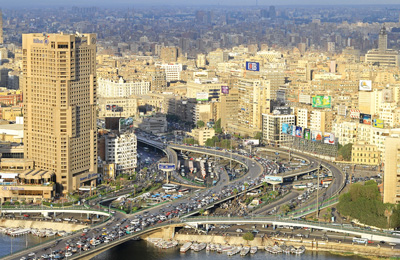
Egypt... stabilised political and economy situation
Moody's changes Egypt's outlook to stable from negative
SINGAPORE, October 20, 2014
Moody's Investors Service has today (October 20) changed Egypt's outlook to stable from negative and affirmed its Caa1 government bond rating.
Key drivers for the outlook change to stable from negative are the stabilised political and security situation, the launch of government initiatives toward fiscal consolidation, signs of a growth recovery and an improvement in macroeconomic stability and strong support from external donors.
However, Egypt's Caa1 government bond rating remains primarily constrained by high fiscal deficits, high government debt, very large fiscal borrowing needs and continued challenges hindering the recovery of economic growth in the post-revolutionary political and economic environment.
Moody's has today also affirmed the Aaa rating of Egypt's backed global bond. Egypt's B3 foreign-currency bond ceiling, Caa2 foreign-currency deposit ceiling and Ba3 local-currency country risk ceilings are unaffected by today's rating affirmation. The short-term country ceilings for foreign-currency bonds and deposits remain unaffected at Not-Prime (NP).
Ratings rationale
The outlook change to stable from negative reflects our expectations of an improving fiscal and economic environment, building on a number of developments over the past year that reduce downside risks to the rating.
The domestic political and security situation has improved, following the constitutional referendum on 14-15 January 2014, which formed the first step in the political reform roadmap and led to greater institutional stability. This was followed by presidential elections in May 2014, with parliamentary elections likely to be held by early 2015.
With the exception of an attack on a Korean tourist group in February 2014, there have been no terrorist assaults on foreign visitors. Most of the violence stems from small-scale attacks on Egypt's security forces, outside the traditional tourist areas.
Coinciding with the stabilizing security situation, the government launched several fiscal and economic reforms over the past year. In July, authorities adjusted administered fuel prices, and unveiled plans to phase out fuel and electricity subsidies over the next five years. The government is also working on revenue-enhancing measures, including a shift from the current goods and services tax to a value-added tax system.
These initiatives target a deficit reduction, with the current fiscal year target set at 10 per cent of GDP, compared with a 12.8 per cent estimated by the Ministry of Finance in fiscal 2014 and 8.5 per cent by 2019. At the same time, the Ministry of Finance plans to stabilize the government debt ratio and reduce it to 80-85 per cent of GDP by 2019.
In addition, economic growth has started to pick up. Real GDP grew by 3.7 per cent year-on-year during the fourth quarter of fiscal 2014, up from 2.5 per cent in the previous quarter, while high frequency indicators support the scenario of a sequential pick-up in growth. The HSBC/Market Purchasing Managers Index rose to a ten-month high of 52.4 in September and tourist arrivals are rising.
Domestic investors are showing confidence in the economic recovery of Egypt. The recent issuance of Suez Canal investment certificates to retail investors was met with high demand and yielded the equivalent of $8.5 billion within one week. Furthermore, the expansion of the canal and development of the surrounding area will be a central supporting factor for economic growth and employment over the next five years at least.
External financial support, predominantly from GCC member states, continues to bolster external liquidity, supporting Egypt's budget and lowering the government's financing costs. The commitment from the Gulf governments remains strong and will likely continue in the future. According to Egypt's Ministry of Finance, Saudi Arabia, Kuwait and the United Arab Emirates have provided almost $17 billion in grants and loans to the Egyptian government and Central Bank of Egypt during fiscal 2014. In addition, the US government has recently resumed military cooperation and other aid.
Rating affirmation
The affirmation of the Caa1 rating reflects the very weak and challenging state of Egypt's government finances. Budget deficits remain wide, at more than 10 per cent of GDP. Government expenditure is marked by a very high share of recurrent spending, which limits room for public investment.
The government's policy of increasing expenditure to meet social welfare demand indicates a gradual pace of fiscal consolidation, with the government envisaging a decline in fiscal deficit, but remaining at an elevated 8.5 per cent of GDP in fiscal 2019.
The government's gross financing requirements are amongst the highest of rated sovereigns, at around 45 per cent of GDP for the current fiscal year 2015, and weakened economic growth, following the first revolution in 2011, has depressed fiscal revenue generation. The unsettled political situation also reversed the declining trend in government debt, causing the debt-to-GDP ratio to rise above 90 per cent, while the ratio of interest payments to government revenue has risen to 34 per cent during the past fiscal year.
Despite some easing of market uncertainty, government funding costs remain elevated.
Relative weak economic growth hinders a more rapid fiscal consolidation. While there are signs of a turnaround in economic performance, Moody's expects real GDP growth to rise only modestly in fiscal 2015, to 3.5 per cent.
Furthermore, the outlook for Egypt's economic growth remains weaker than pre-revolution, when growth averaged 6 per cent between 2007 and 2010. – TradeArabia News Service







